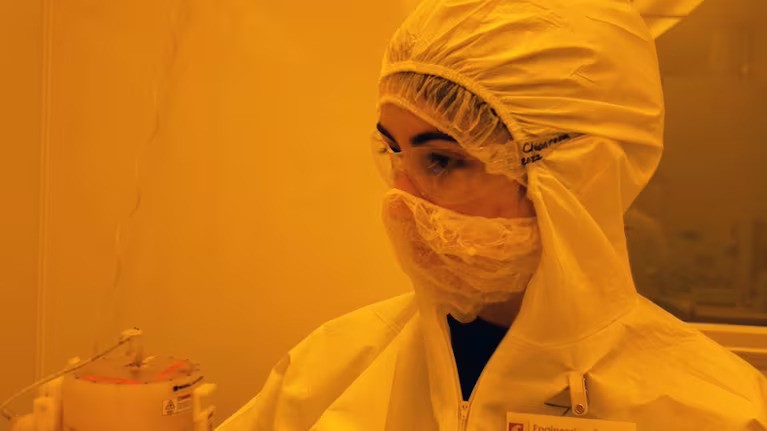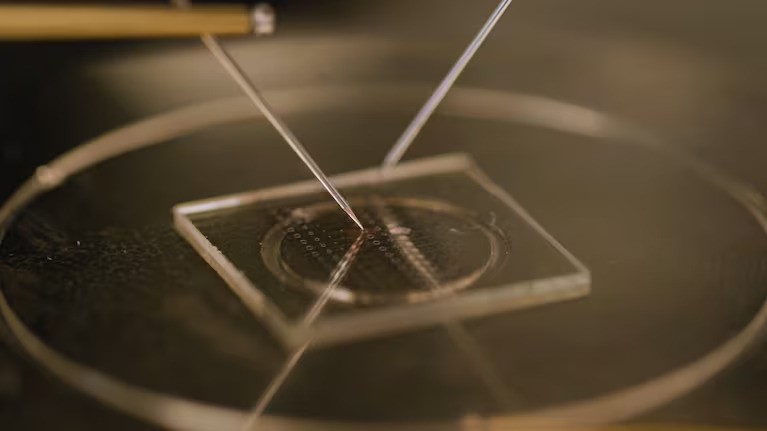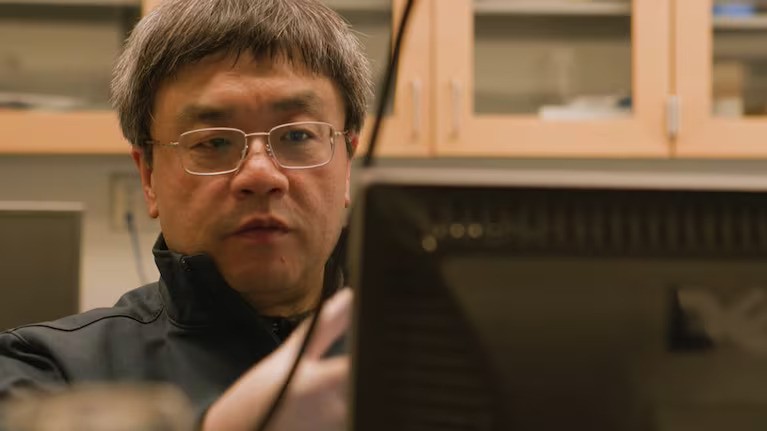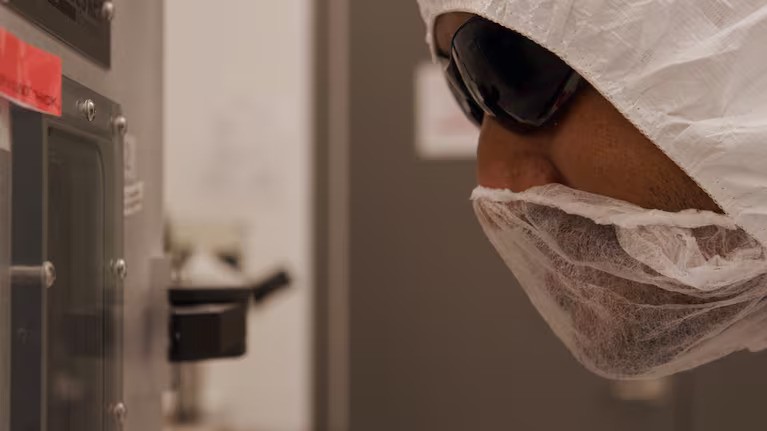In This Computer Component, Data Slides Through Honey
7:20 minutes

This article is part of The State of Science, a series featuring science stories from public radio stations across the United States. This story, by Jes Burns, was originally published by OPB.
A honey bear is probably one of the weirder things you’d see in a science lab, especially in a lab making computer parts.
“It’s just processed, store-bought honey,” said Ph.D. student Zoe Templin. “Off the shelf — a little cute bear so we can put it in photos.”
But for Templin and her colleagues at Washington State University, Vancouver, the honey is key.
“It is cheap and it is easily accessible to everyone,” said master’s student Md Mehedi Hassan Tanim.
The honey also has natural chemical properties that make it a promising foundation for a new kind of environmentally friendly computer component — one that could make computing faster and more energy efficient while reducing the impact on the environment.
“For me electronics in general produce so much toxic waste. It really is a devastating amount of electronic waste that occurs,” said Templin.
In fact, the world produces about 50 million tons of electronic waste per year. Only 20% is recycled, meaning the other 80% ends up in landfills.
Using honey instead of materials like silicon in computers would make recycling easier and less toxic, because honey breaks down in water.
“I would love to see this become a stepping stone to having electronically clean waste,” said Templin. “Actually getting organic materials out into your phone, into commercial use.”

Templin and Tanim have spent a good deal of time in the University’s cleanroom fabricating electronic components called memristors.
“We generally fabricate devices at the start of the semester for like 2-3 weeks and then we test them later,” said Tanim. “I’ve fabricated like 40 to 50 samples, but there are hundreds of devices on each sample.”
The devices are extremely small so the dust-free space of the cleanroom and head-to-toe protective gear is necessary to create the pristine metal and honey layers that comprise the chips.
“We have to keep our devices as clean as they are because our honey film is so thin. Any particles that land on that film… [are] going to be a defect and it is going to affect the performance of our device,” Templin said.
She places a glass slide in a centrifuge and drips a few drops of a specially diluted honey mixture on the surface. She starts the machine, which will spin the honey into an even layer.
“It’s thinner than our hair,” she said.
They’ll make the memristors by sandwiching the honey between two metal electrodes.

Memristors are relatively new in the world of electronics. The term is a portmanteau of the words “memory” and “resistor” — both essential for computers.
The memristor’s function was first theorized in the 1960s, but no one managed to actually make one until 2008.
Its combination of memory and electricity resistance is unique in electronics, but there’s another place where this combo is quite common — in our brains.
Our brains are full of nerve cells called neurons, and we learn when our neurons create connections between each other. The points where the neurons connect are synapses.
When we hear a new piece of information, a small bridge is built across the synapse. The bridge is our memory. The more we hear the information repeated, the more robust that memory bridge becomes.
“So we have our neurons and the synapse, they process data and they store data at the same time,” said WSU Vancouver electrical engineering professor and project head Feng Zhao.
This dual function is a huge deal and helps make our brains the most efficient computer on the planet.
The team’s memristor works the same way. It builds bridges (microscopic filaments of metal atoms) through the honey when exposed to certain levels of electricity — that’s the data processing. When the electricity stops flowing, the bridge remains intact — that’s the memory.
If you reverse the flow of electricity, the memory is wiped clean.
“We are building systems of memory that are as efficient as how the brain stores memory,” said Templin.
Zhao’s lab at WSU Vancouver discovered that honey has the chemical characteristics needed to make memristors work.
“They have big molecule chains in the material. And we need those molecule chains in order for us to build up those bridges,” said Zhao.
The team also focused on honey because it’s stable and doesn’t spoil. And unlike other traditional computer materials, producing honey actually benefits the environment because of the key role bees play in pollination.
“Using honey as the synapse element is great. It’s very clever. It’s a nice advance as far as getting things to be biodegradable,” said Purdue University physicist Erica Carlson. Carlson’s research has similarly focused on finding new materials to create faster, more efficient computers, but she is not involved in the WSU Vancouver project.

So if you have a computer component that mimics a brain cell, could you put a bunch of them together and get a computer that mimics a brain?
The answer is yes.
“Right now our device simulates a single neuron, a single synapse, but we want to integrate those devices together,” said Zhao. “And then this will behave more like our brain.”
This is the idea behind neuromorphic computing — a new revolution in computer design.
“We’re coming up against some hard technological issues to where we need fundamentally different forms of computation if we’re going to keep the world moving forward the way that we want to keep moving forward,” Carlson said.
Pretty much every computer we use is based on a design that’s 80 years old: The von Neumann architecture.
In this design, the part of the computer that processes information is separate from the part that stores it. And it takes time and energy for the information to travel in between.
“This conventional computing system consumes a tremendous amount of energy,” Zhao said.
Neuromorphic computers solve this bottleneck, in part, by having the processor and storage all in one place — the memristor.
“It’s a building block,” said Tanim. “By combining millions of devices like this, I can build a neuromorphic … chip, which can actually do the computation that a supercomputer can do — but 100 times faster and using 1000 times less energy.”

These neuromorphic computer systems are still in their infancy as far as development goes, but that could be changing with the seemingly overnight emergence of artificial intelligence.
“Right now, the way we’re doing AI is we’re using software to mimic the brain, and we’re putting that software on computer architectures that weren’t designed for it. So that’s why it’s so enormously energy intensive,” said Carlson.
It’s estimated that within four years, AI servers like ChatGPT will use as much electricity annually as countries the size of Argentina.
Neuromorphic computer systems could eventually reduce that energy use significantly.
“Now that we’re in the midst of the AI revolution, it would not surprise me if we started to see a lot more funding,” she said. “I mean, we’re trying to do something fundamentally different, and nobody knows which is going to be the best method.”
With honey-based devices, the WSU Vancouver team thinks they’re on track to help solve two problems at once.
By developing a biodegradable computer component made of honey, for a computer system that’s more energy efficient than any we’ve ever seen, the team is taking computers into a faster and cleaner new age.
“I’m actually extremely fortunate to have been raised and grown up in the Pacific Northwest, that cares about the environment to this level,” said Templin. “Where I can do research that could … truly help the environment in a way that really hasn’t been explored before.”
Jes Burns is a science reporter with Oregon Public Broadcasting in Portland, Oregon.
IRA FLATOW: And now it’s time to check in on the state of science.
[AUDIO PLAYBACK]
– This is KER–
– For WWNO.
– Saint Louis Public Radio.
– Iowa Public Radio News.
[PLAYBACK ENDS]
IRA FLATOW: Local science stories of national significance– the world produces 50 million tons of electronic waste each year. Only a small amount of that can be recycled because components like silicon aren’t easily repurposed. What if the solution to this could be an inexpensive sweet treat you can buy at the grocery store?
Honey could make computers not only more environmentally friendly but faster. One laboratory at Washington State University is working to make this a reality. Joining me to talk about this is Jes Burns, science reporter at Oregon Public Broadcasting based in Portland. Welcome back to Science Friday.
JES BURNS: Hey, thanks for having me.
IRA FLATOW: This is a honey of a story about computing, isn’t it?
JES BURNS: Totally, totally.
IRA FLATOW: Sorry.
[LAUGHTER]
Who would have thought about honey and computers? Tell us about that.
JES BURNS: Yeah, broadly, they’re thinking about using honey as a substitute for silicon and other semiconductors that are used in electronics. These are the materials that control the flow of electricity.
But more specifically, the researchers are using honey to create a newer kind of electronic component called a memristor. They dilute the honey. They layer it between electrodes. And then they essentially bake the whole thing to try to dry the honey out. That’s ridiculously simplified, by the way.
But watching them make these chips, it was just such a weird juxtaposition of the absolutely ordinary because they got a honey bear on the table on the lab desk from a big box store, and then you have this crazy high-tech equipment all around us. We’re working in a clean room in these clean suits. It was just it was so bizarre to be there for this.
IRA FLATOW: And these things called memristors, why are they such a hot topic in computing, then?
JES BURNS: This took me a lot of time to figure out what memristors do because, in many ways, they feel a little bit like magic. So it’s a circuit. And it was theorized like back in the 1970s, but it took until about 15 years ago for someone to actually figure out how to make one.
They are a key component of this new kind of computing system called neuromorphic computing. And that’s modeled after how our brains work. Floating around in our skull, we have the most efficient computer on the planet. The amount of information we can process and store in our brains compared to the amount of electricity and energy it takes to do that is pretty astounding. It just blows our normal computing systems away.
So memristors essentially mimic the way our neurons, specifically our synapses, in our brain work, so the connecting pieces between our neurons. They can store information. They can process information all in the same location. And computers that we have now do these things separately, and consequently, they’re a lot slower than neuromorphic computers would be.
IRA FLATOW: So what is it about honey That makes it so good here, because it has this synaptic property?
JES BURNS: Yes, it is. But to get a little bit into the chemistry, I’m going to let the expert talk us through this one. This is Washington State University engineer Feng Zhao.
[AUDIO PLAYBACK]
– So they have a big molecule chains in the material, and we need those molecule chains in order for us to make our devices.
[PLAYBACK ENDS]
JES BURNS: Yeah, so basically, the honey is a substance that you can engineer to have these memristive qualities. They behave like a memory and processing information when different levels of electricity are applied to them. They also like honey because it’s relatively cheap. It doesn’t spoil. And you don’t have to mine it and process it like you do minerals.
IRA FLATOW: Right.
JES BURNS: When you think about it, bees are actually helping the environment. We’re not tearing apart the Earth to get these materials.
IRA FLATOW: What I’m wondering about is I know that honey is mostly sugar. So could you swap out different high fructose corn syrup, for example, instead of the honey?
JES BURNS: They tried fructose. They tried all kinds of things in this kind of sugar category. They tried glucose. They even tried things like aloe vera. But in the end, honey ended up showing the most promise for what they were looking for.
IRA FLATOW: OK, so how does the memristor compare it to something more traditional like silicon, like a computer chip?
JES BURNS: Well, this is such a new technology that I haven’t seen head-to-head comparisons, but it’s probably safe to say the silicone tech is further along in its development because people are using silicone to make memristors. But a really interesting comparison, I think, comes when you’re ready to throw the component away, the end use of the life cycle. So you mentioned 50-million tons of e-waste each year. Only 20% is recycled.
And our current silicon-based computing systems, they contain toxic components. They require some pretty caustic chemicals to break them down into something that’s recoverable. Honey? You just need a little water, and it dissolves.
IRA FLATOW: There you go. Wow, that would be interesting. Now, of course, is this memristor, is it faster than our silicon counterparts?
JES BURNS: The computer system the architecture, if you will, that it’s being designed for, neuromorphic computers, those systems have the potential of being much faster than the style of computers we currently use. The reason for this, in part, is because of the processor and the memory, they happen in the same spot.
So the computer doesn’t have to go and actually like physically go retrieve pieces of information in another location. And we’re talking tiny distances. But when it’s compounded so many times and so many processes that a computer has to go through, it is faster because the information isn’t having to travel so far.
IRA FLATOW: Yeah. So how soon are we going to see this? And is it going to melt on the dashboard of my car [LAUGHS] if I leave it out?
JES BURNS: It won’t melt. It won’t melt. And I asked them about moisture, though, and they looked at me. And they were like, already most of our computers can’t take any moisture. And I was like, oh yeah, that’s right. That’s right.
So anything that’s– the ceiling that we would use for our standard computers would be enough to protect this from moisture. As far as getting this out into the world, there’s a long way to go. It’s kind of the story of science, right?
You get this idea. You test it, and you see if it works. And it shows a lot of promise. But then there’s probably like 20 more steps before it actually gets implemented.
IRA FLATOW: Well, Jes, we’ll keep looking out for this and have you report back if something happens, OK?
JES BURNS: Sounds good.
IRA FLATOW: Jes Burns, science reporter at Oregon Public Broadcasting based in Portland.
Copyright © 2023 Science Friday Initiative. All rights reserved. Science Friday transcripts are produced on a tight deadline by 3Play Media. Fidelity to the original aired/published audio or video file might vary, and text might be updated or amended in the future. For the authoritative record of Science Friday’s programming, please visit the original aired/published recording. For terms of use and more information, visit our policies pages at http://www.sciencefriday.com/about/policies/
Kathleen Davis is a producer and fill-in host at Science Friday, which means she spends her weeks researching, writing, editing, and sometimes talking into a microphone. She’s always eager to talk about freshwater lakes and Coney Island diners.
Ira Flatow is the founder and host of Science Friday. His green thumb has revived many an office plant at death’s door.